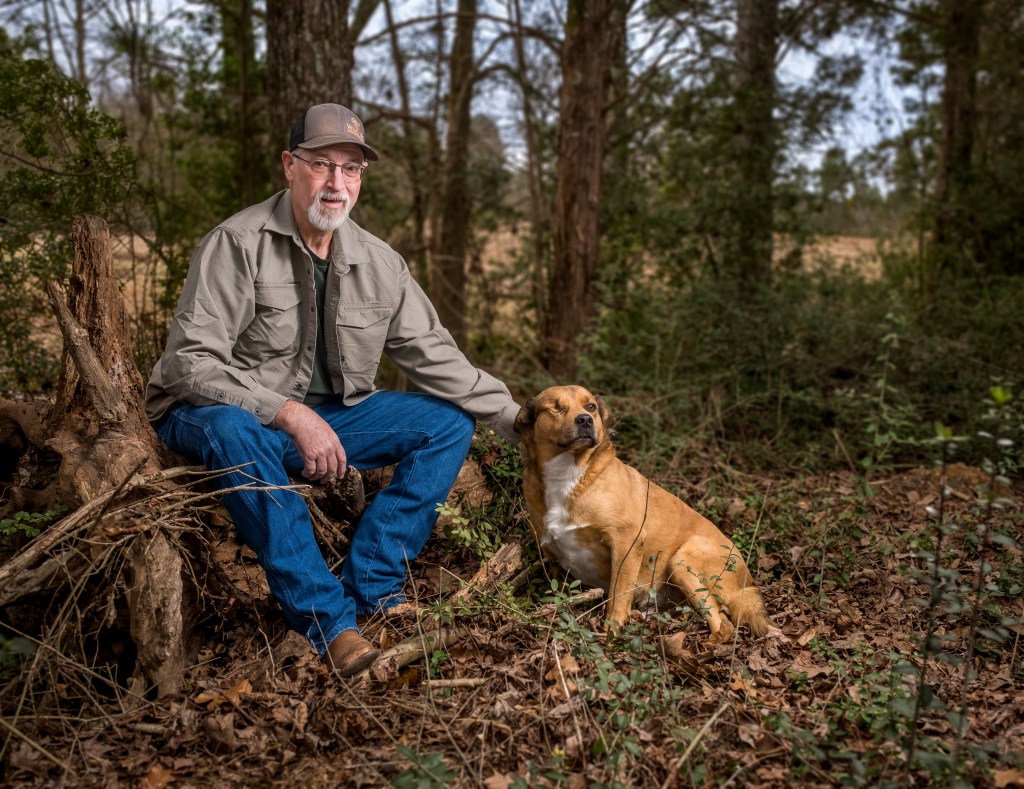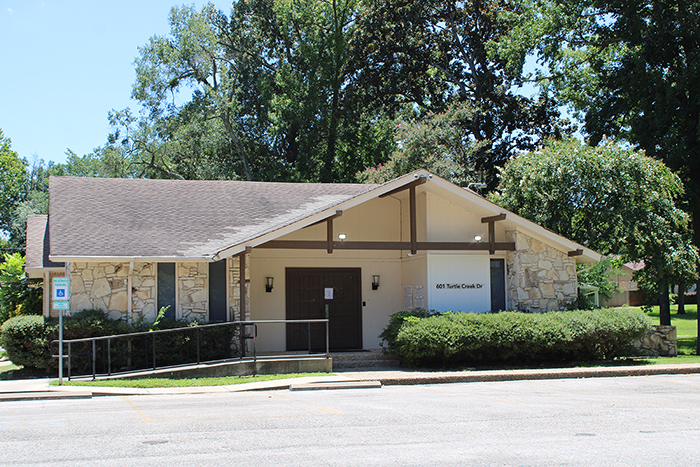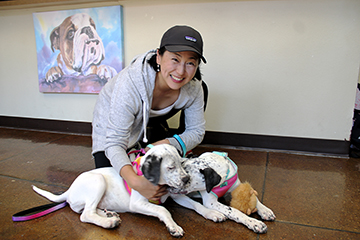Calling and trapping may be sport for some, but for this Big Sandy native, it’s big business – and crucial for the environment
Published 1:14 am Friday, May 2, 2025

- Byron South and Freckles Brown at their home Thursday, February 27, 2025, near Big Sandy. (Les Hassell/ETXView)
To a novice, trapping a coyote might not sound so hard. Big Sandy native Byron South has been doing it for years. Here’s how he describes the work: “People ask me, ‘Well, you think you can catch this? This coyote’s costing me a lot of money.’ I said, ‘Yeah, this place ain’t but what, 3,500 acres? All I gotta do is make him step on a 3-inch circle.”
Of course, such a humorous explanation of predator trapping understates the planning, preparation and perspective a trapper has to have. South makes his living helping landowners of estates, large and small, rid their property of pesky predators by trapping and killing the animals, and he’s known nationally for his ability to call in coyotes, bag bobcats and lure in mountain lions.
Being a wildlife caller and trapper, however, is not merely sport for South. His work is crucial to environmental conservation, livestock protection and the preservation of the predatory species themselves.
Trending
“I don’t hate coyotes. They’re doing what they’re supposed to do,” South said. “But God put us on this planet for a reason, too, and so we’re just stewards of the land.”
Finding his call
On a late February day, South sat underneath a gazebo at his homestead near Big Sandy with his brown, one-eyed dog, Freckles, who’s named after legendary bull-rider Freckles Brown. South was a rodeo cowboy once upon a time, but marriage made him settle down. He had to get a steady job, and that turned out to be calling and trapping – something he’d been doing most of his life.
When he was 10 or 11 years old, South was hauling hay with his uncle and became enthralled by a coyote call on the dashboard of the truck. He blew into the call, and he was fascinated by the sound. His uncle hadn’t had any luck with it, so he let South take it.
Soon afterward, South and a cousin were staying together on their grandparents’ farm, and the two snuck into the woods one night with a 20-gauge shotgun and South’s call. They aimed to kill coyotes, which South’s grandpa called wolves. South got one.
“It’s like I killed a grizzly bear,” he said. “Nobody in my family ever killed a coyote.”
From that point on, whenever South visited the little country store at nearby Shady Grove, the old men who sat on the front porch – where they’d shoot the breeze and whittle on pieces of wood – gave South a title that would make any boy swell with pride: “Wolf killer.”
Trending
That’s where it all began. If South hadn’t killed a coyote that night, he probably would have quit trying, he said. But it wasn’t the killing of the animal that fascinated him. It was all in the call.
“To be able to make that animal come to me stuck in my head,” South said. “That just became a passion and a career. And thankfully, the good Lord has blessed me, and I’ve been able to do it. And I wouldn’t trade it for Elon Musk’s money.”
Up close and personal
For several years now, South has lived on close encounters of the fur kind. As a trapper, he makes a living capturing and killing predators that are wreaking havoc on deer populations, livestock herds and more. As a caller, he draws in animals for hunters to shoot.
When South is around, nature’s predators have met their own.
South uses game calls to replicate the sounds of certain animals that are preyed upon by predators such as bobcats and coyotes. Calls can mimic either the sound of the predatory species being called or the prey that commonly become a predator’s tasty treat. No matter what sound is made, the goal is for predators to answer the call and meet their fate.
For South, getting the critters as close as possible is a competition with himself. Early on in his career, as he was guiding other hunters about calling coyotes, a client of his gave him a VHS tape about the practice.
“It’s supposed to be the biggest thing going,” South said of the VHS tape. “I watched it, and I thought it was horrible. So, I took my home movie camera and started filming some of my hunts.”
Those filmed trips were compiled in two volumes of VHS tapes that propelled him to outdoor renown. The cover of the first volume of “Coming to the Call with Byron South” – showing a picture of the camo-clad hunter holding a bobcat and a coyote – states in orange letters: “Watch As Byron And His Friends Call In Dozens Of Predators, Some VERY CLOSE.”
The tapes wound up on shelves in the nation’s leading outdoor supply stores, including Bass Pro Shops and Cabela’s. Suddenly, South’s name seemed as synonymous with calling coyotes as the sound of the calls themselves. South recorded sounds for calls manufactured by FOXPRO, and “then I started getting hit by everybody in the industry wanting me to record sounds for them,” he said. He later recorded audio for MOJO Outdoors, another game call manufacturer.
South gained sponsorships that sent him around the globe to call in predators and film his expeditions. He was on the professional staffs of outdoor goods maker Realtree and optics manufacturer Nikon, which builds scopes for rifles. Famed gun maker Remington Arms built a rifle in his name, the Remington R-15 VTR (Varmint-Tactical Rifle) Byron South Signature Edition. As its name implies, it was built especially for killing the types of predators South calls and traps. At the time, the company had built only one other signature rifle – and it was made posthumously in honor of NASCAR legend Dale Earnhardt, South said.
“I signed a professional endorsement agreement with Remington and found out later that only two people in the history of Remington ever signed a professional endorsement agreement with Remington: me and Brett Favre, the quarterback,” South said.
South has taken hunters of all kinds on trips, and some are known outside the hunting realm, too. Among them are football players Ryan Jensen, a former NFL center with the Tampa Bay Buccaneers; Joe Thomas, a former offensive tackle for the Cleveland Browns; and Brady Quinn, a former quarterback for the Denver Broncos and Kansas City Chiefs.
He’s called most species of predators in Africa – including the predator that is known throughout the world for its prowess, appearance and stature.
Hear the lions roar
The Mozambican Civil War had been over only a few years by the time South’s flight touched down at a bombed-out airport. It was still a land hunters had dared not venture because of the conflict, but the founder of MOJO, Terry Denmon, wanted to kill a lion. South would be the man to call it in. The two took a 21-day expedition there.
South still recalls one night he spent in the African bush. He heard elephants trumpeting in the distance and lions roaring.
“I thought to myself, ‘Man, if my friends could see me now, because I’m just a booger-picker from Big Sandy, Texas,” South said. “And there I was in Mozambique, in the middle of nowhere, looking at the Southern Cross, completely different constellation in the sky.”
He thought to himself: “Man, if I died right now, I’d be fine. This is a dream come true.'”
But he didn’t really want to die – at least not by becoming a lion’s supper.
South and Denmon had killed a kudu, a large woodland antelope, and chained half of it to a tree about 75 yards away from the Toyota Land Cruiser they were in. A large speaker near the tree played the sound of roaring lions. South strapped a camera to the roll bar of the vehicle to record the action. He was sitting on the other half of the kudu.
Suddenly, South heard a noise. Some natives who were a part of the trip rushed up to him and said: “The lions are coming.”
A female lion rushed toward the truck. South had told his hunting partner that, if a lion came within 40 yards, he was going to shoot it. “I’m coming home alive,” he said.
The lion stopped about 40 yards away from the truck, sat down and looked at South. About that time, he heard lions reach the kudu that was chained to the tree. They began to eat it, and South could hear the sound of the creatures crunching the kudu’s bones.
Denmon took a spotlight and began to shine it around the truck – but the light never shone upon the female lion. The next thing South knew, she was gone.
The hunt didn’t end with a kill, but South still had a thrill hunting the world’s “apex predator.”
“It’s a pinnacle. That’s the ultimate predator in the world,” he said. “They say in Africa there are two kinds of animals: There’s lions, and then there’s food.”
A call with a purpose
Kind of like the oil industry, coyote populations endure brutal boom-and-bust cycles, South said. During times when prey are plentiful, coyotes repopulate – and overpopulate. In turn, they kill off too much prey, and then the predator populations suffer from starvation and sickness. That’s when predators begin to attack livestock and domestic animals. Thus, ranching operations depend on trappers like South for critical protection.
Keeping predator populations steady can help prevent boom-and-bust cycles, improving the quality of life for the population as a whole and ensuring that there’s a healthy balance between predator and prey, South said.
Ironically, keeping the coyote population alive and well means some must die. “It’s kind of hard to tell a coyote, ‘Well, I gotta kill some of these so you can do good,” South said.
The process of trapping can take a while. South has multiple traps that he sets on a given piece of property, and they must be set meticulously. He digs small holes to bury the traps in, places paper over the mechanisms, covers the devices with a thin layer of dirt to disguise them, places bait behind the traps, and then – he waits.
Sometimes, days will pass before a coyote will stumble into a trap. South likes to catch predators by their front right foot. It’s just his preference.
Trapping, South emphasizes, is not a cruel way to control wildlife populations. Quite the opposite, in fact. Movies and cartoons have given people the perception that traps are giant, sharp, claw-like contraptions that cut an animal’s leg off and leave it bleeding. Really, modern traps are more like handcuffs that prevent a coyote from pulling its foot out.
South wouldn’t want the traps to be anything harmful, anyway. Admittedly, he loves coyotes.
“I think they’re the most neat animal in the world, and when I when I dispatch them, I do it the way I’d want to be dispatched — quick and easy and painless as I can,” he said. “I check my traps every day, so when I set that trap, it don’t matter if I’m sick, if it’s raining, if it’s cold, it’s hot. I go check that trap every day because I think there’s an animal out there, could be caught.”
Trapping and calling both require the hunter to think like an animal, not like a human. A hunter must anticipate an animal’s response to a sound or a scent and plan accordingly. And whether a hunter is trapping or calling an animal, “all you can do is ask them to come. That don’t mean they’re going to come,” he said. That can be frustrating.
But for South, it’s still rewarding. When he’s outdoors, he’s in his element.
“I love doing it, and it’s never gotten old,” he said. “I’d be lying if I told you I don’t get tired of it sometimes. I mean, you do anything for a job, it turns into work. But then I think to myself, ‘Well, you knucklehead, you’re living the dream. Shut up and just go do it. You could be in an office job. You could be doing something you hate. But I get to be outside.'”






